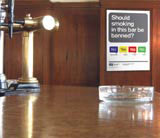Design Council tackles rift between state and public

Encounters between the state and its citizens are a decidedly unfulfilling experience for members of the public, according to the Design Council and the Institute of Public Policy Research.
Under the heading Touching the State, the organisations tracked a small group as they voted, undertook jury service and attended the new citizenship ceremonies. The conclusion was that for most people the experience is largely alienating and frustrating.
The Design Council has called on designers, politicians and academics to consider how design can improve this interaction. The project is the first to be undertaken by Red, the council’s research and development unit, and the resulting essays and a Design Challenge form the basis of a magazine entitled Touching the State.
The magazine features contributions from political thinkers, designers, psychologists, anthropologists and journalists, including Orange director of customer experience Clive Grinyer and designer Thomas Heatherwick.
‘Our role is to take things that are not obviously design issues and bring the design community into them,’ explains Tory Dunn, head of Red. ‘We are examining how the design process can help policy-makers put together an agenda, work out what users really need and [thereby] aid the implementation of solutions.’ The council highlights the fact that voter turnout is at its lowest since World War II and remarks that the citizenship ceremonies have not exactly ‘set pulses racing’. Many encounters with Government are increasingly out of step with experiences in other areas of life, it claims.
It has drawn up a list of 12 quick-fix recommendations, which include improving courtrooms and juror waiting rooms.
According to Julian Grice, managing director of The Team, it is about taking the process to people rather than expecting them to move actively towards it. ‘These are exactly the kind of issues that the Design Council should pick up and stimulate,’ he says.
So what can designers do? Tonic Design decided to tackle the issue of voter apathy by proposing the creation of an independent body called Vote. This would take responsibility for ensuring that citizens are presented with ‘unbiased, clear information’ in locations that are relevant to the issue.
For example, political party policies on smoking in bars could be displayed on posters in pubs, says consultancy creative director Ranzie Anthony.
‘It’s very important that design groups take these kind of briefs on board,’ Anthony explains. ‘If the design community can be more involved in tackling these issues it could help improve awareness of the value of design and move the issue up the agenda.’
Other suggestions from the Touching the State initiative centre on improving lines of communication. Clearer signs at polling stations, a rich visual language for print material issued by the state and the provision of feedback to those who have participated in state interactions, are all presented as routes to improving the overall experience.
-
Post a comment




